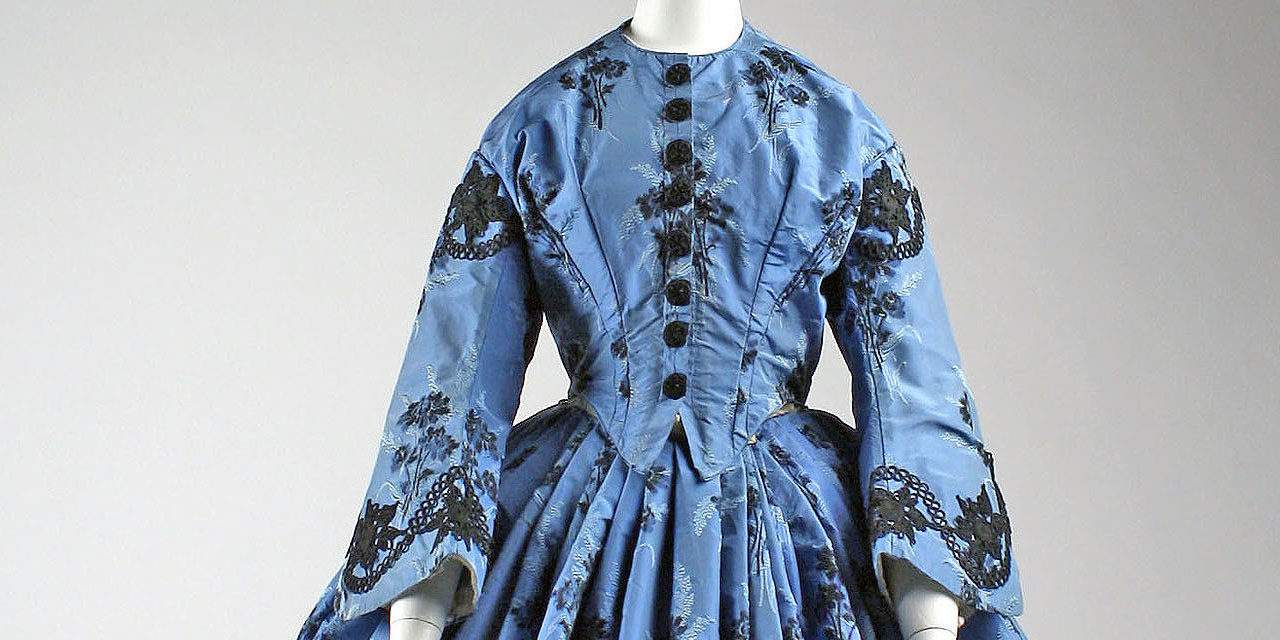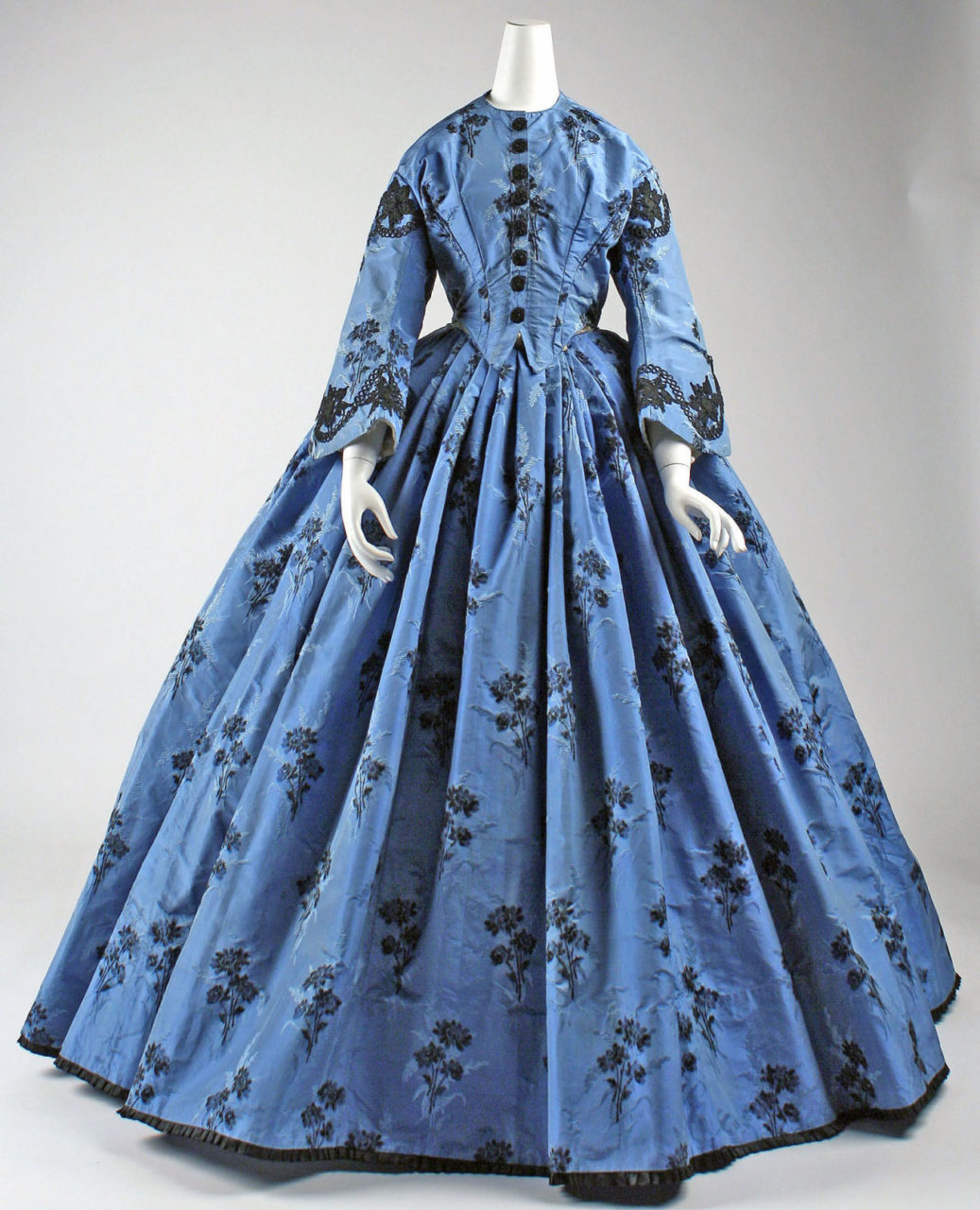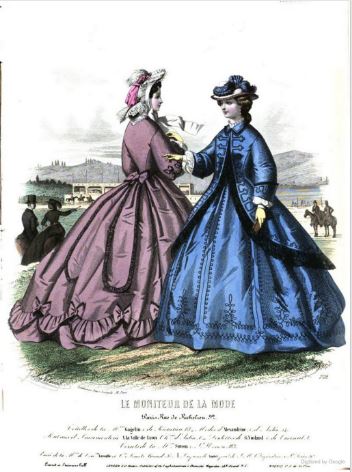This 1863 dress has a simple and standard silhouette for the period—buttoned bodice, wide sleeves, full skirt—but is made fashionable by the floral embroidery, sash, and “Mexican blue” color.
About the Look
This French day dress from 1863 was created by an unknown designer. It features a fairly simple bodice and full skirt in a cornflower blue floral silk fabric (Fig. 4) with various black embellishments. The bodice is a high-neck, double-pointed jacket with pagoda sleeves and beaded black buttons (Fig. 5) down the center front. The sleeves also include two rows of black floral cording along the dropped shoulder and sleeve hem (Fig. 6).
The skirt is gathered along the waistline, and is fairly plain aside from some black and white floral embroidery motifs, as well as a black ribbon trim that peeks from underneath the hem. Underneath, the skirt is fully crinolined, with a slight emphasis in volume towards the rear, hinting at the bustled silhouettes of the following decade. The back of the dress also features two sash tails emerging from the bodice waistline (Fig. 1). Around the edge of each tail lies a more elaborate version of the black sleeve cording, as well as a beaded flower at the bottom of the tails (Figs. 7 & 8).
Fig. 1 - Designer unknown. Rear view, dress, 1863. Silk. New York: The Metropolitan Museum of Art, 1999.123a-c. Gift of Judith and Ira Sommer, 1999. Source: The Met
Fig. 2 - Designer unknown. Exhibition view, dress, 1863. Silk. New York: The Metropolitan Museum of Art, 1999.123a-c. Gift of Judith and Ira Sommer, 1999. Source: The Met
Fig. 3 - Designer unknown. Side view, dress, 1863. Silk. New York: The Metropolitan Museum of Art, 1999.123a-c. Gift of Judith and Ira Sommer, 1999. Source: The Met
Fig. 4 - Designer unknown. Detail, dress, 1863. Silk. New York: The Metropolitan Museum of Art, 1999.123a-c. Gift of Judith and Ira Sommer, 1999. Source: The Met
Fig. 5 - Designer unknown. Button detail, dress, 1863. Silk. New York: The Metropolitan Museum of Art, 1999.123a-c. Gift of Judith and Ira Sommer, 1999. Source: The Met
Fig. 6 - Designer unknown. Sleeve cording, dress, 1863. Silk. New York: The Metropolitan Museum of Art, 1999.123a-c. Gift of Judith and Ira Sommer, 1999. Source: The Met
Fig. 7 - Designer unknown. Sash cording, dress, 1863. Silk. New York: The Metropolitan Museum of Art, 1999.123a-c. Gift of Judith and Ira Sommer, 1999. Source: The Met
Fig. 8 - Designer unknown. Sash cording, dress, 1863. Silk. New York: The Metropolitan Museum of Art, 1999.123a-c. Gift of Judith and Ira Sommer, 1999. Source: The Met
Dress, 1863. Silk. New York: The Metropolitan Museum of Art, 1999.123a-c. Gift of Judith and Ira Sommer, 1999. Source: The Met
About the context
T
his ensemble was quite stylish for its time, and would fit in perfectly alongside any other dress in the period. As noted above, the silhouette itself is very standard for 1863: a high-neck, fitted bodice or jacket with buttons down the front (Figs. 11-13), paired with a very full bell skirt, achieved with the help of a crinoline. Sleeves were also full, and the shoulder seams were set lower than usual.
Jackets with skirts or two-piece dresses became widespread in the late nineteenth century due to their versatility and affordability. A popular silhouette dubbed the “Postillion” by the Englishwoman’s Domestic Magazine in 1863 shares many of the same features with the bodice of the floral silk dress, including the double-pointed waistline (Figs. 9, 13):
“Fancy Jackets and Waistcoats appear to be more in vogue than ever – the Zouave, the Spanish Senorita Jacket, and the Postillion being the three shapes that divide popular favour . . . The bodice portion is made to fit the figure with two points in front like a dress bodice” (189).
Fairly simple silhouettes with embellishments and vivid colors proved to be very popular in the early 1860s (Fig. 12). The shade of blue featured in the silk dress was particularly flattering, and it became a favored choice for spring dresses (Figs. 9, 13, 14) The Englishwoman’s Domestic Magazine remarks positively on the color of the silk dress in its 1863 article “The Fashions”:
“The following colours are destined to be very fashionable: —Mexican blue, nankeen, dove-colour, Chinese green, with varieties of purple, and all shades of grey and of buff, and such undefined tints.” (84)
Sashes were also prevalent, and added volume to the front or back of a skirt. They appeared in many different variations: most were tied in bows or knots at the the waistline, as seen in Godey’s Lady’s Book (Fig. 11), but some were simply attached without any extra fanfare. A fashion plate from Les Modes parisiennes (Fig. 10) features a similar sash with embellishments around the edge.
The “La Mode” column in the October 1864 issue of the French Magazine Le Follet maintains that sashes are still very popular for women’s dresses:
“The wide sash, tied behind, is still worn with both silk and ball dresses . . . The sash to match the dress is equally à la mode”
Fig. 9 - Designer unknown. Deaccessioned two-piece periwinkle gown, ca. 1864. Silk. Source: Pinterest
Fig. 10 - Designer unknown. Godey's Lady's Book, vol. 63, pg. 9 (July 1861). Source: HathiTrust
Fig. 11 - Artist unknown. Les Modes Parisiennes, August 1862. Source: New York Public Library Digital Collections
Fig. 12 - Designer unknown. Visiting dress, 1863-1865. Silk, cotton, glass. New York: The Metropolitan Museum of Art, May, 1977, 1977.204.2a,b. Gift of Alhtea Adams. Source: The Met
Fig. 13 - Designer unknown. Dress, 1867. Silk. New York: The Metropolitan Museum of Art, 1940. C.I.40.164.1a-c. Gift of Miss Mary L. Dayton. Source: The Met
Fig. 14 - Artist unknown. Le Moniteur de la mode, vol. 3, no. 708 (May 1863). Source: Google Books
References
- “Dress,” ca 1863. https://www.metmuseum.org/art/collection/search/82121.
- “La Mode.” Le Follet 18, no. 217 (October 1863). https://books.google.com/books?id=dh0GAAAAQAAJ
- “The Fashions.” The Englishwoman’s Domestic Magazine 6, no. 34 (February 1863): 189.
- “The Fashions.” The Englishwoman’s Domestic Magazine 6, no. 36 (April 1863): 84.

























